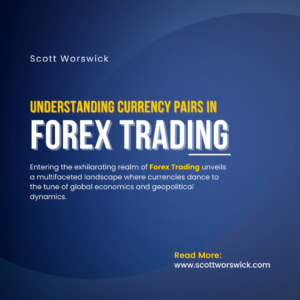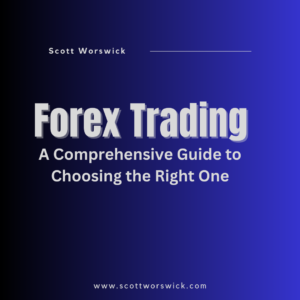In today’s fast-paced financial landscape, many individuals are seeking innovative ways to achieve financial independence. One such promising avenue is forex trading, a dynamic and potentially lucrative market that allows traders to buy and sell currencies from around the world. Unlike traditional investment options, forex trading offers unparalleled flexibility, with the market operating 24 hours a day, five days a week. This continuous operation presents unique opportunities for traders to capitalize on global economic events and trends, making it an attractive option for those aiming to take control of their financial future.
Forex trading stands out not only for its accessibility but also for its potential for high returns. With daily trading volumes exceeding $6 trillion, the forex market is the largest and most liquid financial market globally. This immense liquidity means that traders can execute large orders without significantly affecting the market price, providing a level playing field for both novice and experienced traders. Additionally, the use of leverage in forex trading allows traders to control substantial positions with a relatively small amount of capital, amplifying both potential profits and risks. This combination of high liquidity and leverage makes forex trading a compelling choice for those looking to build wealth and achieve financial independence.
However, success in forex trading is not guaranteed and requires a strategic approach. Traders must develop a deep understanding of market dynamics, economic indicators, and geopolitical events that influence currency movements. Employing robust risk management strategies and maintaining psychological discipline are also critical to navigating the volatile forex market effectively. By dedicating time to education and practice, traders can enhance their skills and increase their chances of achieving consistent profitability. Ultimately, forex trading offers a viable pathway to financial independence for those willing to invest the effort and discipline required to master this complex yet rewarding market.
Table of Contents
Benefits of Forex Trading
1. High Liquidity: A Pillar of Forex Trading
High liquidity is one of the defining characteristics that sets the forex market apart from other financial markets. In the context of forex trading, liquidity refers to the ease with which a currency can be bought or sold in the market without causing a significant impact on its price. The forex market’s immense liquidity is primarily due to its vast size, with a daily trading volume exceeding $6 trillion. This high volume of transactions ensures that there is always a substantial number of buyers and sellers, facilitating smooth and efficient trade executions.
The benefits of high liquidity in forex trading are manifold. First and foremost, it enables traders to enter and exit positions swiftly, which is crucial for capitalizing on short-term market movements and taking advantage of minute price fluctuations. This ability to quickly execute trades at desired prices minimizes the risk of slippage, where a trade is executed at a different price than expected. Slippage can erode potential profits, especially for day traders and scalpers who rely on precision in their trading strategies. High liquidity thus enhances the reliability and predictability of trade outcomes, which is a significant advantage for all types of traders.
Another significant advantage of high liquidity is the reduced risk of price manipulation. In less liquid markets, large trades by influential entities can cause substantial price swings, leading to market distortions and unfair trading conditions. However, in the highly liquid forex market, the vast number of participants and the enormous volume of trades make it exceedingly difficult for any single entity to manipulate prices. This democratization of the market ensures a fairer trading environment where prices more accurately reflect the true supply and demand dynamics of the currencies involved. Consequently, traders can have greater confidence in the market’s integrity and the fairness of their trading activities.
High liquidity also supports the use of advanced trading strategies and sophisticated financial instruments. For instance, the availability of diverse currency pairs and the ease of executing large orders allow traders to implement complex strategies like arbitrage, hedging, and algorithmic trading. These strategies can be highly effective in the forex market due to the constant availability of trading opportunities and the minimal impact of large trades on market prices. Additionally, high liquidity often correlates with lower transaction costs, as brokers can offer tighter spreads between the bid and ask prices. Lower costs contribute to higher net profitability for traders, further reinforcing the appeal of forex trading as a pathway to financial independence.
2. 24/5 Market Access
One of the most compelling features of forex trading is its 24/5 market access, offering traders unparalleled flexibility. Unlike stock markets, which operate during specific hours, the forex market remains open continuously from Sunday evening to Friday evening. This non-stop trading schedule is made possible by the global nature of forex, with trading sessions spanning major financial centers such as Tokyo, London, and New York. As one major market closes, another opens, ensuring a seamless transition and uninterrupted trading opportunities. This around-the-clock access allows traders to respond promptly to global economic events, news releases, and market movements, regardless of their geographical location.
The flexibility of 24/5 market access is particularly beneficial for individuals who seek to integrate trading into their diverse schedules. Whether you are a full-time professional, a student, or someone managing other commitments, forex trading accommodates your lifestyle. You can choose to trade during the Asian session, which is typically quieter and ideal for those who prefer a more relaxed pace, or during the European and American sessions, known for higher volatility and trading volumes. This adaptability not only makes forex trading accessible to a broader audience but also enables traders to optimize their strategies based on the time of day and their personal preferences.
Moreover, the continuous nature of forex trading presents numerous opportunities to capitalize on market volatility and profit from short-term price movements. Major economic data releases, central bank announcements, and geopolitical events often occur outside regular business hours, significantly impacting currency values. With 24/5 market access, traders can take advantage of these developments as they happen, rather than waiting for the market to open. This immediate responsiveness can be crucial for executing timely trades and maximizing potential gains. For instance, a trader who monitors the markets closely can swiftly act on unexpected news, adjusting positions to hedge risks or capture profits, thereby enhancing their overall trading performance.
3. Leverage
Leverage is a powerful feature in forex trading that allows traders to control large positions with relatively small amounts of capital. This mechanism works by borrowing funds from the broker to increase the size of a trade, effectively amplifying both potential profits and potential losses. For instance, with a leverage ratio of 100:1, a trader can control a $100,000 position with just $1,000 of their own money. This ability to magnify trading capacity without needing substantial upfront investment makes leverage particularly attractive to those aiming for financial independence through forex trading.
The strategic use of leverage can significantly enhance a trader’s ability to profit from small market movements. Since currency values typically change in small increments, having the ability to leverage positions allows traders to capitalize on these slight fluctuations more effectively. This is particularly beneficial in the highly liquid forex market, where minor price movements can occur frequently. However, it’s crucial to understand that while leverage can amplify gains, it also increases the risk of substantial losses. Therefore, successful traders employ rigorous risk management techniques, such as setting stop-loss orders and maintaining appropriate position sizes, to mitigate the potential downsides of using leverage.
Despite the risks, the proper use of leverage can be a game-changer for traders looking to maximize their returns and achieve financial independence. By carefully managing leverage, traders can optimize their investment strategies, allowing their capital to work harder and achieve higher returns than would be possible through unleveraged trading. This aspect of forex trading underscores the importance of education and discipline; understanding how to effectively use leverage, combined with a sound trading plan and risk management strategy, can transform forex trading from a speculative venture into a sustainable pathway to financial freedom. The key lies in balancing ambition with caution, ensuring that leverage serves as a tool for growth rather than a source of undue risk.
4. Low Transaction Costs
One of the significant advantages that make forex trading an appealing pathway to financial independence is the low transaction costs associated with it. Unlike other financial markets where hefty commissions and fees can erode profits, forex trading typically involves minimal costs. Most forex brokers charge a spread, which is the difference between the buying and selling price of a currency pair, as their primary fee. These spreads are often very tight, especially in major currency pairs like EUR/USD or GBP/USD, meaning that traders can enter and exit positions without substantial costs cutting into their profits.
The competitive nature of the forex market ensures that transaction costs remain low. With numerous brokers vying for traders’ business, there is constant pressure to offer attractive pricing structures. This competition benefits traders by providing them with access to favorable trading conditions and lower costs. Moreover, many brokers now offer commission-free trading, relying solely on spreads to generate revenue. This transparency in cost structure allows traders to better calculate their potential expenses and net profits, making financial planning and strategy formulation more straightforward.
Low transaction costs also make forex trading accessible to a broader audience, including those with smaller capital bases. High transaction costs in other markets can act as a barrier to entry, limiting participation to those with substantial capital. In contrast, the low costs in forex trading mean that even small trades can be profitable. This inclusivity allows more individuals to explore and engage in forex trading, democratizing access to the financial markets and providing a viable opportunity for anyone seeking to achieve financial independence. Additionally, the ability to trade in small increments, or micro-lots, further reduces the financial barrier, allowing traders to start with modest investments and gradually build their portfolios.
Furthermore, the low transaction costs in forex trading facilitate more frequent trading and the use of short-term trading strategies. Traders can capitalize on small price movements without worrying about significant fees eating into their profits. This is particularly advantageous for day traders and scalpers who rely on making numerous trades throughout the day to generate returns. The cost-efficiency of forex trading thus supports a wide range of trading styles and strategies, from long-term investment to high-frequency trading. By keeping costs low, traders can retain more of their earnings, accelerating their journey toward financial independence.
Strategies for Successful Forex Trading
1. Fundamental Analysis
Fundamental analysis is a critical approach in forex trading that involves evaluating a country’s economic indicators, political stability, and overall financial health to determine the future movements of its currency. Unlike technical analysis, which focuses on historical price data and charts, fundamental analysis delves into the underlying factors that drive currency values. By understanding these macroeconomic fundamentals, traders can make more informed decisions, aligning their trades with long-term economic trends rather than short-term market fluctuations. This deep insight into economic conditions provides a solid foundation for achieving financial independence through forex trading.
Key economic indicators play a pivotal role in fundamental analysis. Factors such as Gross Domestic Product (GDP) growth rates, unemployment figures, inflation rates, and consumer spending are closely monitored as they reflect the overall health of an economy. For instance, a country experiencing robust GDP growth and low unemployment is likely to see its currency strengthen, as these indicators signal economic stability and investor confidence. Conversely, high inflation or economic downturns can weaken a currency. Traders who pay attention to these indicators can anticipate currency movements and position themselves advantageously in the market.
Central bank policies are another crucial aspect of fundamental analysis in forex trading. Decisions regarding interest rates, monetary policy, and economic stimulus measures significantly influence currency values. Central banks, such as the Federal Reserve in the United States or the European Central Bank, use these tools to manage economic growth and control inflation. For example, an interest rate hike typically strengthens a currency as higher rates attract foreign investment. Conversely, rate cuts can lead to a depreciation. By staying informed about central bank policies and upcoming meetings, traders can predict potential market reactions and adjust their strategies accordingly.
Geopolitical events and stability also have a profound impact on currency markets, making them essential components of fundamental analysis. Political events such as elections, trade negotiations, and international conflicts can create significant volatility in forex markets. For example, uncertainty during an election period can weaken a country’s currency due to potential changes in economic policies. On the other hand, positive trade agreements can boost investor confidence and strengthen a currency. Traders who keep abreast of geopolitical developments can better anticipate market shifts and make timely decisions, thereby enhancing their ability to achieve financial independence through forex trading.
2. Technical Analysis
Technical analysis is an essential methodology in forex trading that involves the study of historical price movements and trading volumes to forecast future market behavior. By analyzing charts and using various technical indicators, traders can identify patterns and trends that provide insights into potential price movements. Unlike fundamental analysis, which focuses on economic factors, technical analysis relies solely on past market data, making it a valuable tool for traders aiming to capitalize on short-term fluctuations and achieve financial independence.
The core of technical analysis lies in its ability to identify trends and chart patterns. Traders use tools like moving averages, Bollinger Bands, and the Relative Strength Index (RSI) to analyze the market’s past performance and predict future movements. For example, moving averages smooth out price data to create a single flowing line, making it easier to spot trends over time. Bollinger Bands, on the other hand, measure market volatility and provide high and low points based on standard deviations from a moving average. These tools help traders determine entry and exit points, identify potential reversals, and set stop-loss levels to manage risk effectively. By systematically applying these indicators, traders can develop strategies that enhance their profitability in forex trading.
Chart patterns are another critical aspect of technical analysis, offering visual representations of market psychology and behavior. Patterns such as head and shoulders, double tops and bottoms, and flags and pennants can signal potential market reversals or continuations. For instance, a head and shoulders pattern typically indicates a reversal from a bullish to a bearish trend, while a double bottom suggests a potential upward movement. Recognizing these patterns allows traders to anticipate market changes and make informed decisions. Furthermore, technical analysis is not limited to specific time frames; it can be applied to intraday, daily, or weekly charts, providing flexibility for traders with different trading styles and time horizons.
3. Risk Management
Risk management is a critical component of successful forex trading, serving as the backbone for sustaining long-term profitability and achieving financial independence. In the volatile world of forex, where currency values can fluctuate rapidly due to various factors, effective risk management strategies are essential to protect against significant losses. This involves setting predefined rules and guidelines for every trade, ensuring that potential risks are minimized and trading capital is preserved.
One of the foundational principles of risk management in forex trading is the use of stop-loss orders. A stop-loss order automatically closes a position when the market moves against the trader by a specified amount, limiting potential losses. This tool is crucial for maintaining discipline and preventing emotional decision-making, which can often lead to catastrophic financial outcomes. Additionally, traders should also consider position sizing, which involves determining the appropriate amount of capital to allocate to each trade based on the level of risk they are willing to accept. By carefully managing the size of their trades, traders can ensure that no single loss will have a devastating impact on their overall portfolio.
Diversification is another key element of risk management in forex trading. Instead of concentrating all capital in a single currency pair, spreading investments across multiple pairs can reduce exposure to any one particular market risk. This approach helps to mitigate the impact of adverse movements in any single currency and can stabilize returns over time. Furthermore, traders should continually monitor their open positions and the broader market environment, ready to adjust their strategies as necessary. This proactive approach to risk management ensures that traders are always prepared to respond to changing market conditions, thereby safeguarding their path to financial independence through forex trading.
4. Psychological Discipline
Psychological discipline is arguably the most critical yet challenging aspect of forex trading, as it directly influences a trader’s ability to make rational decisions and maintain consistency. The forex market is inherently volatile and unpredictable, often triggering emotional responses such as fear, greed, and impatience. These emotions can cloud judgment and lead to impulsive decisions that undermine trading strategies. Developing psychological discipline is essential for traders seeking financial independence through forex trading, as it enables them to stay focused, adhere to their trading plans, and navigate market fluctuations with confidence.
One of the foundational elements of psychological discipline in forex trading is the ability to control emotional responses. Emotional trading often results in overtrading, chasing losses, or abandoning well-thought-out plans in favor of hasty decisions. For instance, the fear of missing out (FOMO) can push traders to enter positions prematurely, while the anxiety of potential losses might lead them to exit trades too early. By cultivating emotional resilience and maintaining a calm, objective mindset, traders can better manage their reactions to market movements. Techniques such as mindfulness, meditation, and regular breaks from trading can help in developing this emotional control.
Another crucial aspect of psychological discipline is the commitment to a trading plan. Successful forex traders meticulously develop and adhere to their trading strategies, which outline their entry and exit points, risk management rules, and overall objectives. Sticking to this plan, even in the face of market volatility, requires strong discipline. This commitment prevents emotional decision-making and helps traders maintain a long-term perspective, focusing on consistent performance rather than short-term gains or losses. Regularly reviewing and refining the trading plan based on market conditions and performance analysis is also vital for continuous improvement and adapting to evolving market dynamics.
Moreover, psychological discipline encompasses the patience to wait for the right trading opportunities. Forex trading often requires waiting for specific setups that align with one’s trading strategy. Impatience can lead to premature trades that do not meet the criteria, increasing the likelihood of losses. By practicing patience and waiting for high-probability setups, traders can improve their chances of success. Additionally, accepting that losses are a natural part of trading and not allowing them to affect future decisions is crucial. Learning from losses and viewing them as opportunities for growth rather than failures fosters a resilient and disciplined trading mindset.
Conclusion
Forex trading stands out as a compelling pathway to financial independence for individuals willing to invest time, effort, and discipline into mastering the intricacies of the market. With its high liquidity, 24/5 market access, and potential for high returns, forex trading offers unparalleled opportunities for traders to build wealth and achieve their financial goals. Whether you’re a novice exploring the world of trading or an experienced investor seeking to diversify your portfolio, forex trading provides a dynamic platform to capitalize on global economic trends and market movements.
However, success in forex trading is not guaranteed and requires a strategic approach. Traders must equip themselves with a solid understanding of fundamental and technical analysis, employing risk management techniques and maintaining psychological discipline to navigate the market’s inherent uncertainties. By embracing continuous learning, adapting to evolving market conditions, and honing their skills, traders can unlock the full potential of forex trading as a pathway to financial independence. It’s not just about making profits; it’s about cultivating a mindset of resilience, patience, and perseverance to withstand the challenges and setbacks along the way.
Ultimately, forex trading offers more than just financial rewards; it offers a journey of personal growth and empowerment. Through diligent practice, prudent decision-making, and a commitment to lifelong learning, traders can transform their financial futures and carve out a path to lasting prosperity. Whether you’re seeking to escape the confines of traditional employment, pursue your passions, or secure a comfortable retirement, forex trading provides a gateway to realizing your dreams. Embrace the journey, seize the opportunities, and embark on the exciting adventure of forex trading towards financial independence.






